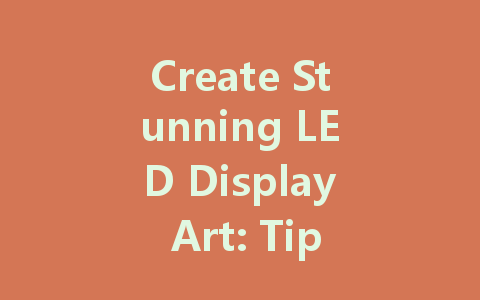
LED display art is an exciting way to blend technology with creativity, creating vibrant visuals that can enhance any environment. Whether you’re looking to decorate your home, create engaging installations for public spaces, or simply explore a new hobby, LED art offers endless possibilities. In this article, we’ll delve into practical tips and ideas to help you craft your own stunning LED displays.
Understanding LED Displays
Before jumping into the art itself, it’s essential to grasp the different types of LED displays available. Typically, LED technology utilizes diodes to produce light and can be configured in various formats, including:
Understanding these types of displays will help you select the best medium for your creative vision.
Getting Started: Materials and Tools
Creating LED display art requires some basic materials and tools. Here’s a quick list to help you prepare for your project:
With these materials in hand, you’re ready to unleash your creativity!
Designing Your Artwork
Design is the backbone of any artistic endeavor. What do you want your LED display to represent or convey? Here are some design concepts to consider:
Creating abstract patterns can be a relaxing yet satisfying design choice. Play with color gradients and rhythmic patterns to mesmerize your viewers. Tools such as generative design software could help in generating random patterns programmatically.
Consider a theme for your display that resonates with your audience. It could be nature, space, or a festive celebration. By using varying sizes of LEDs and arranged colors, you can evoke visuals from sunsets, galaxies, or holiday festivities.
For a more immersive experience, consider incorporating sensors that allow your LED display to react to stimuli. For example, using motion sensors can let the lights change position or color as viewers approach, making the experience more captivating.
LEDs can effectively convey messages or quotes. You could program your display to show motivational quotes or even a dynamic text animation that captures attention.
Programming Your Display
Once you have your design planned out, it’s time to bring it to life through programming. If you are using a microcontroller like Arduino, here are some basics to guide you:
Assembling Your Display
Now comes the fun part—assembling your artwork! Take a moment to organize your workspace so that you can work comfortably. Here’s a step-by-step guide:
Showcasing Your Artwork
Once your LED display art is complete, consider how and where to showcase it. Here are some ideas:
Conclusion
Creating stunning LED display art combines technology with artistic expression in an exciting way. With a bit of imagination, the right tools, and some programming know-how, you can create eye-catching displays that resonate with viewers. Remember to experiment and have fun throughout the process, as the journey is just as important as the final product. Get started today, and let your creativity shine!